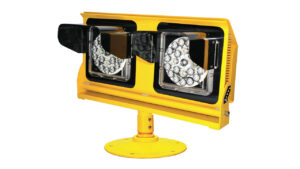Runway guard light (RGL) is a yellow, unidirectional and flashing lighting unit. It is used to warn pilots and vehicle drivers that they are about to enter an active runway. Runway guard lights are installed at taxiway and runway intersections.
The primary purpose of runway guard lights is to increase the visibility of runway junctions in low visibility conditions. It can be used in all weather conditions to increase visibility and safety.
Runway guard lights are placed on both sides of the taxiway. The two signal lamps on the raised body light up alternately. These lights flash synchronously between 30 and 60 times per minute, making an effective warning.
The body of the runway guard lights is aluminum powder coated in the color known as aviation yellow. Similarly, the fixing system is made of aluminum material. There is an anti-glare glossy black visor on the signal modules. The signal visor provides enhanced contrast against sunlight and offers protection in harsh weather conditions.

Runway guard lights installed in the past and still in use include low-efficiency and short-lived incandescent lights. Low power consumption LEDs are used in the new generation runway guard lights. The power consumption of these lights is 20 W on average and the light intensity is over 3000 candelas.
The runway guard light is mounted directly on the ground. The electrical connection of the signal lamps can be made via 110/220 V AC mains voltage, 24 V DC power supply or 6.6 A airport constant current supply. There are also solar and self-sustaining runway guard lights. Solar units are ideal for temporary installations and portable operations. Solar lights can be controlled remotely via radio frequency.
Runway guard lights must be resistant to corrosion, very low and very high temperatures, high humidity and strong winds. It should have built-in protection against voltage surges and lightning. The signal body must be vertically and horizontally adjustable.
Aviation signal lights are essential to the safety of pilots, passengers and airport officials. All light fixtures used on the runway and taxiway must meet the requirements of AC 150/5345-46E (Specification for runway and taxiway light fixtures) issued by the Federal Aviation Administration (FAA).
